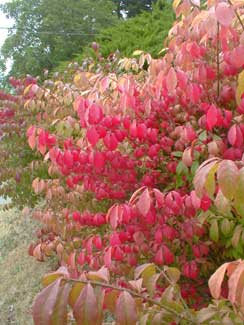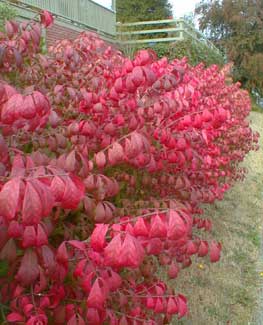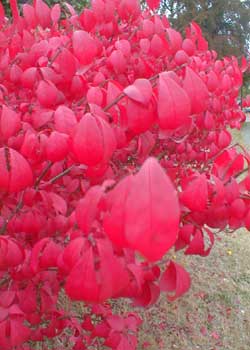
Burning Bush
"Wild puffing of emerald trees,
and flame-filled bushes."
-David Herbert Lawrence
(1885-1930)
(1885-1930)
Burning Bush (Euonymus alatus) is native to China. The cultivar 'Compacta' is somewhat vase-shaped when young, becoming a roundish flat-topped bush when mature, wider than it is tall if left unpruned.
It is suited to zones 5 through 8. Here in the Northwest they tend to be very much over-utilized. Our garden has none, but only because they're so easily appreciated in other peoples' gardens, & there is a long row of them growing immediatley across the street from our home.
 'Compacta' does not provide the extremely interesting little autumn fruits that dangle beneath four tiny sepals. Nor does it have the ridged corky bark of the species. So if I had room for one I'd much rather have the species which slowly grows to fifteen feet high & wide, with inconspicuous May flowers & the fascinating fruits that become most visible as autumn leaves are falling. The majority of cultivars fruit poorly if at all, & the hedge across the road from us has never fruited.
'Compacta' does not provide the extremely interesting little autumn fruits that dangle beneath four tiny sepals. Nor does it have the ridged corky bark of the species. So if I had room for one I'd much rather have the species which slowly grows to fifteen feet high & wide, with inconspicuous May flowers & the fascinating fruits that become most visible as autumn leaves are falling. The majority of cultivars fruit poorly if at all, & the hedge across the road from us has never fruited.The primary feature for 'Compacta' is the reliably extremely bright autumn leaf color. It will begin to redden in August, is in full fiery color in September, & holds its leaves until October.
 Slow growing, 'Compacta' can eventually reach a considerable size even though smaller than the species. Old shrubs that are never pruned can reach eight feet width & nearly as tall. Fortunately they respond well to shearing & shaping, & can be used either as loose hedges with annual pruning, or as specimens allowed to take their full natural broad layered shape.
Slow growing, 'Compacta' can eventually reach a considerable size even though smaller than the species. Old shrubs that are never pruned can reach eight feet width & nearly as tall. Fortunately they respond well to shearing & shaping, & can be used either as loose hedges with annual pruning, or as specimens allowed to take their full natural broad layered shape.They are somewhat susceptible to chlorosis if not given a dose of fertilizer to start off each spring. It does well in full sun or in partial shade, but does not have such extreme autumn color if grown in shade. Its ideal soil condition is moist, well drained, & to the acidic side of the pH scale. Although it adapts well to other conditions including droughty roadsides, it is susceptible to diseases & pests in a stressful situation, & will not look its best if summers are too dry. In a sunny spot in humusy soil & adequate water it will be trouble free.
It's such a beautiful shrub especially in autumn that it is certainly understandable why so many people buy burning bushes. But there are a number of less common shrubs with superb autumn colors that might be selected instead, or in greater variety for a mixed hedge.
Because this shrub is so awfully over-utilized, a deciduous hedgerow arranged for autumn colors could less commony include shadblow serviceberry (Amelanchier canadensis), chokeberry (Aronia melancarpa), Asian witchhazels (Hamamelis x intermedia), fothergilla (Fothergilla gardenii x major 'Mount Airy'), rusty blackhaw (Viburnum rufidulum), tea viburnum (V. setigerum), Sargent's highbush cranberry (V. sargentiana 'Onondaga'), doublefile viburnum (V. plicatum 'Shasta'), dwarf varieties of Japanese maples (such as Acer palmatum 'Crimson Queen'), redbud hazel (Disanthus cerdifolius), or deciduous azaleas (for example, White Throat Azalea with intense autumn color).